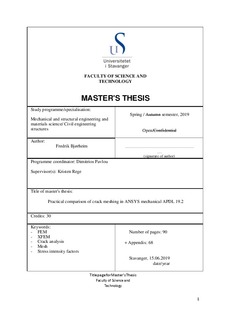| dc.description.abstract | Structures under cyclic loading are typically subjected to formation of cracks, and thereafter crack propagation. To be able to analyse the crack propagation numerically with the goal of estimating a structure or a structural part’s life span, many methods have been proposed, where two examples are:
1. Finite element method, with collapsed Q8 elements to describe the singularity present near the crack tip. In this case, remeshing is required as the crack grows.
2. Extended finite element method, where the elements are enriched with extra nodes to be able to describe the discontinuity, and singularity present. By using this method, the crack can propagate through the elements, hence no requirement for remeshing.
Both methods depend on the numerical evaluation of stress intensity factors (SIFS). This means that the accuracy of a crack propagation analysis, will depend on the accuracy achieved for the SIFS. This thesis will focus on the accuracy obtained for SIF evaluation on a stationary crack, from a practical perspective, where the obtained results will be compared to analytical solutions.
In this project two geometries have been tested, using both methods, and checking which parameters are of importance regarding the method used. The first geometry is a slanted through thickness crack, and the second is a curved through thickness crack. Both of these cracks have analytical formulas if the crack is present in an infinite plate.
The findings are that explicitly modelling the crack using the finite element method gives higher accuracy and requires fewer elements, than the extended finite element method.
When the cracks were explicitly modelled, it was possible to obtain results within 0,1% deviation with very few elements. Whereas the extended finite element method required a rather high mesh density to obtain a deviation within 1%.
This thesis contains a theoretical and an experimental section. The theoretical section describes general linear elastic fracture mechanics and the numerical methods used. | nb_NO |
